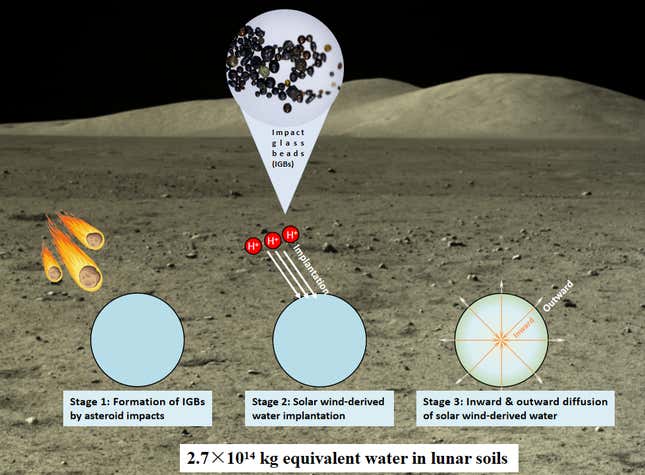Researchers studying lunar soil samples from China’s Chang’e-5 mission believe they may have found a water reservoir on Earth’s arid satellite.
- Off
- English
The evidence comes from beads of impact glass collected by the Chang’e 5 lander, which arrived on the Moon in December 2020 and sent lunar samples back to Earth the same month. The team’s findings are published today in Nature Geoscience.
Advertisement
Water has previously been found on the Moon. Centuries ago, the large dark splotches on the lunar surface were thought to be seas (or “maria,” in Latin) on the surface, nomenclature which has stuck around to this day. Though those features turned out to be basalt plains, evidence of water has since been detected in tiny glass beads in the lunar soil, and hydrated minerals were spotted on the lunar surface by the Cassini mission.

G/O Media may get a commission
Advertisement
Advertisement
In two papers published in 2020, NASA scientists found that water molecules sit on the Moon’s sunlit surface, and water ice could lurk in the satellite’s shadowy recesses.
Water on the lunar surface is lost to space, indicating that there must be a hydrated layer or reservoir that replenishes the Moon’s supply, according to a Chinese Academy of Sciences release. But the source of that supply has remained a mystery.
Advertisement
In the new paper, a team of researchers posit that glass beads in the lunar soil formed by asteroid impacts give rise to solar wind-derived water. The water present in the glass beads diffuses throughout the lunar surface.
“These findings indicate that the impact glasses on the surface of the Moon and other airless bodies in the solar system are capable of storing solar wind-derived water and releasing it into space,” said Hu Sen, a planetary scientist at the Chinese Academy of Sciences, in the release.
Advertisement
Solar wind-derived water sounds like a sci-fi concept, but in 2019 simulations, a NASA team showed how the solar wind—a stream of charged particles from the Sun—could interact with electrons on the Moon, enriching the soil with hydrogen atoms. The hydrogen then could cling onto oxygen present in the lunar regolith, producing good old H2O.
“We think of water as this special, magical compound,” said William M. Farrell, a plasma physicist at NASA’s Goddard Space Flight Center, in a NASA release about the simulations. “But here’s what’s amazing: every rock has the potential to make water, especially after being irradiated by the solar wind.”
Advertisement
Further observations will help clarify the role of glass beads in the lunar water cycle—revelations the upcoming Artemis missions will hopefully provide. NASA’s Lunar Flashlight mission is also scanning the Moon’s south pole for water ice.
More: NASA Hatches New Plan for Troubled Water-Hunting Lunar Probe
Services Marketplace – Listings, Bookings & Reviews